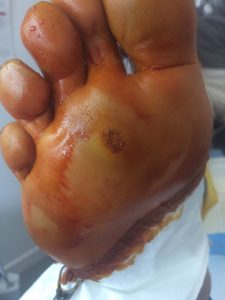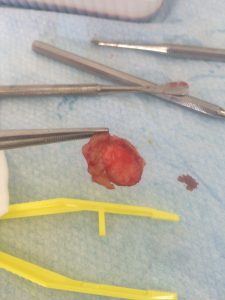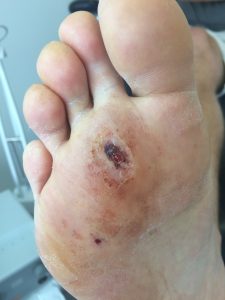Do your feet seem to sweat more than others? Do they regularly carry an unpleasant…
Verruca Treatments
Verrucae (singular: verruca) are a type of wart that appear on the soles of the feet. They are caused by the human papillomavirus (HPV), which infects the outer layers of the skin when there is a break or weakness in the skin’s integrity. Verrucae are common and can affect people of all ages, though they are particularly prevalent in children, teenagers, and those with weakened immune systems.
At Masterton Foot Clinic, we offer a range of evidence-based verruca treatments tailored to the severity and persistence of the wart.
How to Tell a Verruca from a Corn or Callus
Verrucae are often confused with corns and calluses, as they can all appear as hard, rough skin and may be painful when walking. However, there are key differences that help with identification:
- Skin striations (natural skin lines): If you look closely, verrucae interrupt the skin’s natural striations (fingerprint-like patterns), causing them to go around the lesion. Corns and calluses, however, allow the skin lines to continue through them.
- Pain response: Verrucae tend to be most painful when squeezed from the sides, whereas corns are more painful when pressed directly downward.
A correct diagnosis is essential for effective treatment, so if you’re unsure, a podiatrist can help determine the best course of action.
Verruca Treatments at Masterton Foot Clinic
Depending on the size, depth, and duration of the verruca, different treatment options may be recommended. Some verrucae resolve on their own as the immune system fights off the virus, while others persist for months or even years without treatment.
Salicylic acid or other chemical treatments
How it works:
Salicylic acid and other chemical treatments work by gradually breaking down the layers of hard skin covering the verruca, allowing the immune system to target the virus more effectively. These acids also cause mild irritation, stimulating an immune response to clear the infection.
Effectiveness:
- Over-the-counter salicylic acid treatments are available at pharmacies, but professional application combined with podiatric debridement (removal of dead skin) ensures better penetration and efficacy.
- This is a cost-effective and relatively painless treatment option but requires consistency and multiple applications over several weeks or months.
Liquid nitrogen
How it works:
Cryotherapy involves freezing the verruca using liquid nitrogen (-186°C) to damage the infected tissue and trigger the immune system to clear the virus. The extreme cold creates a separation between the verruca and the healthy skin beneath, often forming a small blood blister as the body begins to shed the affected tissue.
Effectiveness:
- Clinical cryotherapy performed by a podiatrist is more effective than over-the-counter cryotherapy kits, which use dry ice or CO2 (-109°C) and do not penetrate as deeply.
- The treatment can be painful for 24-48 hours post-application, but it is one of the most effective minimally invasive treatments available.

In the picture about you can see the verruca has separated/delaminated from the healthy skin below it. If you look closely you can see the wart has a white centre and the healthy skin is red and vascular. It is normal to expect this to seal over within a matter of days.
Surgical treatment- Blunt Dissection
In some cases surgery is the quickest and best option for treating plantar warts. This involves using a local anaesthetic to numb the area and a blunt dissection using a blunt scalpel is performed to completely remove the lesion. This is taught at the NZ School of Podiatry and is almost exclusively performed by podiatrists in NZ.
The benefits of this proceedure are that success rates are high, treatment time is minimal and patients are able to continue to walk afterwards albeit gingerly or with an aid. The risks of surgery are scarring and infection, both of which are reduced when performed by a well trained podiatrist under sterile surgical conditions- which incidentally is exactly what we offer at Masterton Foot Clinic! Healing time is up to 4 weeks.

 Above is an image of a large verruce under the right forefoot.
Above is an image of a large verruce under the right forefoot.
 …and then 7 days following removal
…and then 7 days following removal
Other Verruca Treatment Considerations
In addition to direct treatment methods, we always consider:
- Immune system support: since warts are caused by a virus, a strong immune response is essential for complete clearance. People with compromised immune systems, such as those with diabetes or autoimmune conditions, may find verrucae more difficult to treat.
- Footwear and hygiene: warts are highly contagious in damp environments like swimming pools, communal showers, and gym changing rooms. Wearing flip-flops in these areas and avoiding direct contact with affected skin can reduce the risk of spreading or reinfection.
- Laser and needling techniques: in severe or recurrent cases, alternative treatments such as dry needling may be explored, particularly when other methods fail.
Which Foot Wart Treatment is Right for You?
The best treatment option depends on the size, location, and duration of your verruca, as well as personal factors like pain tolerance and medical history. You can learn more about how we manage foot warts here.
At Masterton Foot Clinic, our team of podiatrists can assess your verruca and recommend the most appropriate treatment plan for you. If you’d like to discuss your options or book an appointment, give us a call or book online today.
